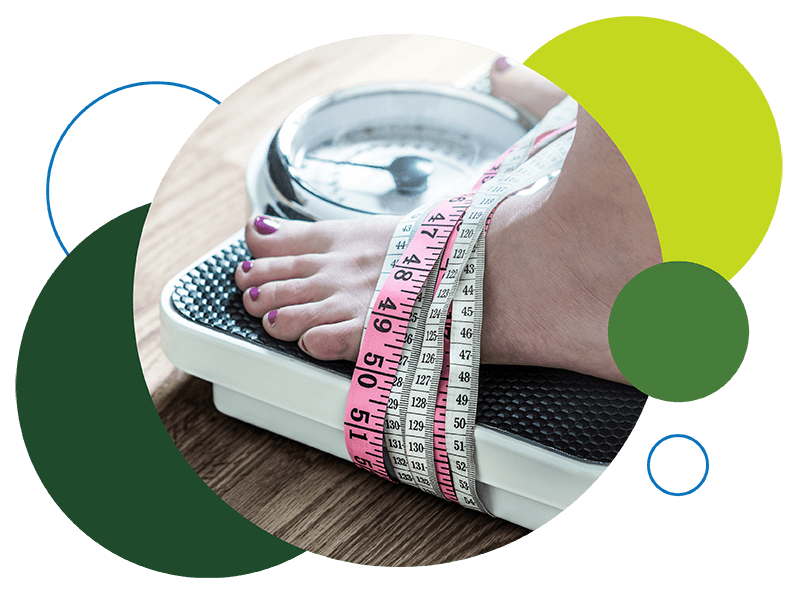Eating Disorder Treatment, San Diego
Contrary to popular belief, eating disorders are not a lifestyle choice; these are serious and often fatal illnesses that cause severe hindrances to a person’s nutrition intake

Telltale Signs
An unhealthy obsession with food, body weight, and a low self-esteem are the typical red flags that signal towards an eating disorder. Eating disorders frequently appear during the teen years or young adulthood. However, they may also develop during childhood or later in life.
These conditions affect both genders, although rates among women are higher than among men. Like women who have eating disorders, men also have a distorted sense of body image.
For example, men may have muscle dysmorphia, a type of disorder marked by an extreme concern with becoming more muscular. Researchers have found that eating disorders are caused by a complex interaction of genetic, biological, behavioral, psychological, and social factors.
Treatment Regime
- Individual Therapy, Cognitive-Behavioral Therapy and Dialectical Behavioral Therapy
- Mindfulness
- Family Therapy, including the Maudsley approach
- Motivational Interviewing
- Medical Services with prescriptions and lab work
- Nutritional Counseling
- Group Therapy

Compassionate Care for Eating Disorders
Our eating disorder treatment program is easily accessible to residents of San Diego, California. While our recovery programs are tailored to every individual’s specific needs, if our ongoing assessment indicates that your condition is severe, we’ll make arrangements to transfer you to a more appropriate intensive outpatient program. There are several different types of eating disorders out there and they all require different levels of care. Our team of specialists provides comprehensive treatments for a number of mild-moderate eating disorders
Anorexia Nervosa
Anorexia nervosa is a severe and potentially life-threatening eating disorder, with one of the highest mortality rates among psychological illnesses.
It often stems from deep-seated issues with body image, self-worth, and an overwhelming fear of gaining weight.
Even when dangerously underweight, individuals with anorexia may still see themselves as overweight, leading to extreme food restriction and an obsessive focus on thinness.
Many engage in rigid dieting, excessive exercise, or other harmful behaviors to maintain control over their body shape, often denying the severity of their condition. Recognizing the signs and seeking professional support early can make a significant difference in recovery and overall well-being.
- Extremely restricted eating
- Extreme thinness (emaciation)
- A relentless pursuit of thinness and unwillingness to maintain a normal or healthy weight
- Brittle hair and nails
- Dried, pale skin
- Severe constipation
- Weak bones as a result of osteoporosis
- Low motivation, lethargy and weakness
- Ceased menstrual periods due to lack of nutrition
Bulimia Nervosa
Bulimia nervosa is characterized by recurring episodes of binge eating, where individuals consume unusually large amounts of food while feeling a loss of control.
To compensate, they engage in behaviors such as self-induced vomiting, excessive use of laxatives or diuretics, fasting, or extreme exercise.
Unlike anorexia, those with bulimia often maintain a weight within the normal range, making it harder for loved ones to recognize the condition. The secrecy surrounding bingeing and purging can lead to feelings of shame, guilt, and isolation, further reinforcing the cycle.
Over time, bulimia can cause severe health complications. Early intervention and professional treatment can help individuals regain control, develop a healthier relationship with food.
- Chronically inflamed and sore throat
- Swollen salivary glands in the neck and jaw area
- Worn tooth enamel and increasingly sensitive and decaying teeth as a result of exposure to stomach acid
- Acid reflux disorder and other gastrointestinal problems
- Intestinal distress and irritation from laxative abuse
- Severe dehydration from purging of fluids
- Electrolyte imbalance (too low or too high levels of sodium, calcium, potassium and other minerals) which can lead to stroke or heart attack
Binge-Eating Disorder
Binge-eating disorder is marked by repeated episodes of consuming excessive amounts of food in a short period, often accompanied by a sense of loss of control.
Unlike bulimia, these episodes are not followed by purging, fasting, or excessive exercise, leading many individuals to struggle with weight gain over time.
This can increase the risk of serious health conditions such as diabetes, high blood pressure, and heart disease. The disorder is often driven by emotional distress, with binge episodes triggered by stress, anxiety, or low self-esteem.
Feelings of shame and guilt frequently follow, creating a harmful cycle that can be difficult to break alone. However, with proper support and therapeutic interventions, individuals can develop healthier coping mechanisms and regain control over their eating habits.
- Consuming unusually large amounts of food in a specific amount of time even when you’re full or not hungry
- Eating really fast during binge episodes
- Eating until you’re uncomfortably full
- Eating alone or in secret to avoid embarrassment
- Feeling distressed, ashamed, or guilty about your eating
- Frequently dieting, possibly without weight loss
Otherwise Specified Feeding or Eating Disorder (OSFED)
OSFED is a serious and often overlooked eating disorder that affects individuals who don’t fit the strict diagnostic criteria for anorexia or bulimia but still struggle with disordered eating patterns.
Despite being less well-known, OSFED accounts for nearly 30% of all diagnosed eating disorders and can be just as physically and emotionally damaging. Unfortunately, misconceptions about its severity have made access to treatment and insurance coverage more challenging for many who need help.
OSFED can manifest in a variety of ways, including restrictive eating, bingeing, purging, or obsessive concerns about food and body image. Because its symptoms vary widely, those affected often go undiagnosed or dismissed.
- Frequent episodes of consuming very large amount of food followed by behaviors to prevent weight gain, such as self-induced vomiting
- Evidence of binge eating, disappearance of large amounts of food in short periods of time or lots of empty wrappers and containers indicating consumption of large amounts of food
- Self-esteem overly related to body image
- Dieting behavior
- Expresses a need to “burn off” calories taken in
- Evidence of purging behaviors, including frequent trips to the bathroom after meals, signs and/or smells of vomiting, presence of wrappers or packages of laxatives or diuretics
Avoidant Restrictive Food Intake Disorder (ARFID)
ARFID is an eating disorder marked by extreme selectivity in food choices, often due to sensory sensitivities to texture, smell, or taste.
While commonly seen in children, it can persist into adulthood, leading to significant nutritional deficiencies.
Unlike anorexia or bulimia, ARFID isn’t driven by concerns about body image or a desire for thinness. Instead, it stems from an aversion to certain foods, sometimes linked to past negative experiences like choking or gastrointestinal discomfort.
Left untreated, ARFID can result in severe malnourishment, unintentional weight loss, and complications in physical development. Early intervention with a qualified specialist can help individuals expand their diet, improve their relationship with food, and ensure they receive the necessary nutrients for long-term health.
- Dramatic weight loss accompanied by an inability to gain weight and nutritional deficiencies
- Limited range of preferred foods that becomes narrower over time (i.e., picky eating that progressively worsens)
- Disrupted digestive system and gastrointestinal complications
- Eating abnormally slowly and having a lack of appetite
- Being paranoid choking or vomiting when presented with “fear” foods
- No fear of weight gain or loss
Pica
Pica is an eating disorder characterized by the persistent craving and consumption of non-food items with no nutritional value, such as dirt, chalk, paper, or metal.
While it can occur in anyone, it is most commonly seen in pregnant women, young children, and individuals with intellectual or developmental disabilities.
The health risks associated with pica vary depending on the substances consumed, but they can be severe—ranging from gastrointestinal blockages to poisoning from toxic materials like lead or paint chips.
In some cases, pica may be linked to nutritional deficiencies, such as iron or zinc, though the exact cause often varies. Proper diagnosis and intervention are essential to address both the behavioral aspects of the disorder and any underlying medical concerns that may be contributing to it.
- The persistent eating, over a period of at least one month, of substances that have no nutritional value
- Typical substances ingested tend to vary with age and availability. They may include paper, soap, cloth, hair, string, wool, soil, chalk, talcum powder, paint, gum, metal, pebbles, charcoal, ash, clay, starch, or ice
Rumination Disorder
Rumination disorder is a condition in which individuals repeatedly and unintentionally regurgitate food, either spitting it out or re-swallowing it.
Unlike other eating disorders, this is not a conscious choice but rather a reflexive response rooted in a miscommunication between the brain and the digestive system.
Various factors can exacerbate the condition, including heightened sensitivity in the gastrointestinal tract, psychological stressors, and even past viral infections. While it can affect people of all ages, rumination disorder is often seen in infants, individuals with developmental disabilities, or those who have experienced trauma.
If left untreated, it can lead to malnutrition, weight loss, and damage to the esophagus. With proper intervention—such as behavioral therapy and medical support—individuals can learn to manage symptoms and restore healthy eating patterns.
- Repeated regurgitation of food for a period of at least one month. Regurgitated food may be re-chewed, re-swallowed, or spit out
- If occurring in the presence of another mental disorder (e.g., intellectual developmental disorder), it is severe enough to warrant independent clinical attention
Orthorexia
What begins as a commitment to healthy eating can sometimes spiral into orthorexia—a condition marked by an overwhelming fixation on food quality, purity, and nutritional value.
Unlike other eating disorders that focus on quantity or body image, orthorexia is driven by a rigid need to eat only “clean” or “healthy” foods, often leading to extreme dietary restrictions.
This obsession can stem from underlying obsessive-compulsive tendencies, anxiety, or a desire for control, making social situations and daily life increasingly difficult. Over time, orthorexia can result in severe nutritional deficiencies, unintentional weight loss, and psychological distress.
Recognizing the fine line between mindful eating and unhealthy fixation is crucial. With professional support, individuals can rebuild a balanced approach to nutrition without fear or guilt.
- Cutting out an increasing number of food groups (all sugar, all carbs, all dairy, all meat, all animal products)
- An increase in concern about the health of ingredients; an inability to eat anything but a narrow group of foods that are deemed ‘healthy’ or ‘pure’
- Spending hours per day thinking about what might be served at upcoming events
- Self image concerns may or may not be present
Compulsive Exercise
Compulsive exercise goes beyond a dedication to fitness—it becomes an uncontrollable urge to work out, often at the expense of physical and mental well-being.
Much like orthorexia’s fixation on “clean” eating, this condition is driven by an intense need to exercise, even when injured, exhausted, or unwell.
Those struggling with compulsive exercise may feel immense guilt or anxiety if they miss a workout, failing to recognize that overtraining can weaken the body rather than strengthen it.
Over time, excessive exercise can lead to chronic injuries, hormone imbalances, and severe fatigue. Addressing this condition involves finding a healthier relationship with movement—one that prioritizes balance, recovery, and overall well-being rather than punishment or control.
- Exercise that significantly interferes with important activities, occurs at inappropriate times or in inappropriate settings, or occurs when the individual exercises despite injury or other medical complications
- Intense anxiety, depression and/or distress if unable to exercise
- Exercise takes place despite injury or fatigue